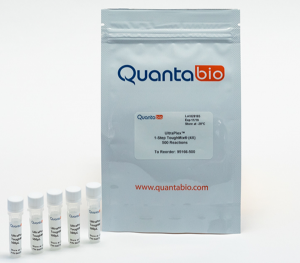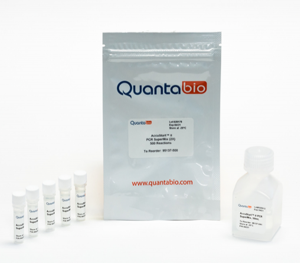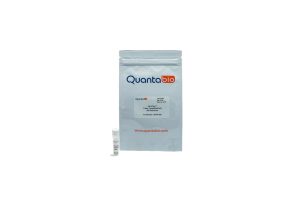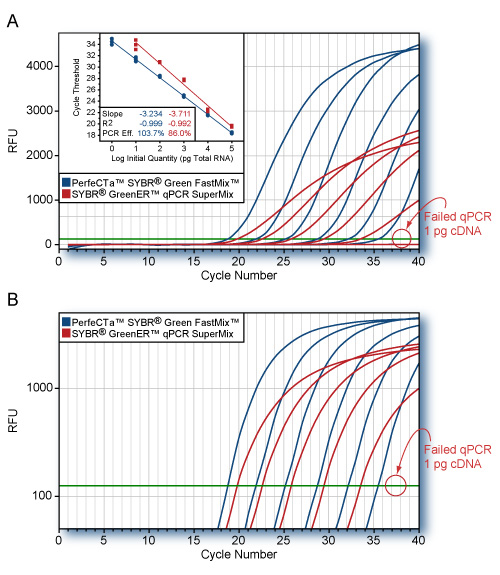5PRIME Phase Lock Gel
| Product | Kit Size | Order Info |
|---|---|---|
| Phase Lock Gel - Light | 200 tubes | Order (2302820) |
| Phase Lock Gel - Heavy | 200 tubes | Order (2302820) |
Documents
Description
Features & Benefits
- Eliminates interphase contamination of the nucleic acid solution
- 30% greater yield of nucleic acids over the conventional method
- Gel barrier allows easy sample decanting
- Reduced contact with hazardous organic solvents
Description
5PRIME Phase Lock Gel (PLG) is a unique product that eliminates interphase-protein contamination during phenol extraction and ensures faster results with improved recoveries. PLG migrates to form a tight seal between the phases of an aqueous/organic extraction during centrifugation. The organic phase and the interphase materials are effectively trapped in or below the barrier, thus enabling complete and easy decanting or pipetting of the entire aqueous phase. The benefits are increased yields of up to 30%, increased protection from exposure to hazardous compounds, and no risk of interphase sample contamination.
PLG can be adapted to virtually any protocol requiring extraction of an aqueous sample with phenol and/or chloroform1. For convenience, PLG is provided pre dispensed into standard 2mL centrifuge tubes and comes in two varieties:
PLG Heavy
Aqueous phase: High density sample (for example, high salt content).
Organic phase: Standard mixtures of phenol, chloroform, isoamyl alcohol with a chloroform fraction of at least 60% (Phenol as the sole organic solvent is not compatible with PLG Heavy).
PLG Light
Aqueous phase: Low-density sample
Organic phase: Standard mixtures of phenol, chloroform, isoamyl alcohol.
PLG is inert and stable to mild heating, and it does not interfere with any of the standard nucleic acid restriction and modification enzymes. The reactions can be carried out in the presence of PLG at the appropriate temperature and then terminated and extracted by the addition of phenol or phenol/chloroform to the reaction tube. PLG can be present during the heating stage of the deactivation of enzymes (65°C for 10 min.) prior to the organic extraction.
Applications
- Genomic DNA from Mouse Tails: Use PLG Heavy to enhance isolation of genomic DNA from mouse tails using a standard proteinase K/SDS organic extraction protocol.
- Plasmid DNA Isolation: Use PLG Heavy to enhance isolation of plasmid DNA using standard alkaline lysis/phenol extraction protocols.
- Total RNA Isolation: Use PLG Heavy to enhance isolation of total RNA from cells and tissues using a modified guanidinium isothiocyanate/acid phenol method.
- Genomic DNA Isolation: Use PLG Light to enhance isolation of genomic DNA using standard proteinase K/SDS procedures.
- DNA Isolation from Agarose Gels: Use PLG Light to enhance isolation of DNA fragments from agarose gels using phenol extraction procedures.
- Lamba Phage or M13 DNA Isolation: Use PLG Light to enhance isolation of bacteriophage DNA using standard purification protocols.
200 2mL tubes
5PRIME Phase Lock Gel is stable when stored at room temperature (DO NOT FREEZE). Phase Lock Gel is inert and does not interfere with standard nucleic acid restriction and modification enzymes. Phase Lock Gel can be present during the heat inactivation of enzymes (65°C for 10 minutes) prior to organic extraction. For lot specific expiry date, refer to package label, Certificate of Analysis or Product Specification Form.
Product Manuals
Technical Notes
Publications
Joanna E. Haye-Bertolozzi, Genome Instability – 2017
ABSTRACT
Incorporation into DNA of nucleoside analogs like 5-bromo-2′-deoxyuridine (BrdU) is a powerful tool for in vivo studies of DNA synthesis during replication and repair. Immunoprecipitation of BrdU-labeled DNA analyzed by DNA sequencing (BrdU-IP-seq) allows for genome-wide, sequence-specific tracking of replication origin and replication fork dynamics under different conditions, such as DNA damage and replication stress, and in mutant strains. We have recently developed a quantitative method for BrdU-IP-seq (qBrdU-seq) involving DNA barcoding to enable quantitative analysis of multiple experimental samples subjected to BrdU-IP-seq. After initial barcoding of multiple, individually BrdU-labeled genomic DNA samples, a pooling strategy is used for all subsequent steps including immunoprecipitation, amplification, and sequencing, which eliminates sample-to-sample variability in these steps. Parallel processing of an aliquot of the pooled input sample provides a direct control for the normalization of the data and yields results that allow quantitative comparisons of the experimental samples. Though developed for the analysis of S. cerevisiae, this method should be directly adaptable to other model systems.
Compartmentalized partnered replication for the directed evolution of genetic parts and circuits
Zhanar Abil, Nature Protocols – 2017
ABSTRACT
This protocol describes the procedures for compartmentalized partnered replication (CPR), an emulsion-based directed evolution method for the generation of proteins, genetic elements, and genetic circuits with improved or altered function.
Óscar Herrero, PLOS ONE – 2018
ABSTRACT
Bisphenol S (BPS) is an industrial alternative to the endocrine disruptor bisphenol A (BPA), and can be found in many products labeled “BPA-free”. Its use has grown in recent years, and presently it is considered a ubiquitous emerging pollutant. To date there is a lack of information on the effects of BPS on invertebrates, although they represent more than 95% of known species in the animal kingdom and are crucial for the structure and proper function of ecosystems. In this study, real-time RT-PCR was used to determine the early detrimental effects of BPS on the transcriptional rate of genes in the model species Chironomus riparius, specifically those related to the ecdysone pathway (EcR, ERR, E74, Vtg, cyp18a1) crucial for insect development and metamorphosis, stress and biotransformation mechanisms (hsp70, hsp40, cyp4g, GPx, GSTd3) that regulate adaptive responses and determine survival, and ribosome biogenesis (its2, rpL4, rpL13) which is essential for protein synthesis and homeostasis. While 24-hour exposure to 0.5, 5, 50, and 500 μg/L BPS had no effect on larval survival, almost all the studied genes were upregulated following a non-monotonic dose-response curve. Genes with the greatest increases in transcriptional activity (fold change relative to control) were EcR (3.8), ERR (2), E74 (2.4), cyp18a1 (2.5), hsp70 (1.7), hsp40 (2.5), cyp4g (6.4), GPx (1.8), and GST (2.1), while others including Vtg, GAPDH, and selected ribosomal genes remained stable. We also measured the transcriptional activity of these genes 24 hours after BPS withdrawal and a general downregulation compared to controls was observed, though not significant in most cases. Our findings showed that BPS exposure altered the transcriptional profile of these genes, which may have consequences for the hormone system and several metabolic pathways. Although further research is needed to elucidate its mode of action, these results raise new concerns about the safety of BPA alternatives.
Jenifer Monks, Nutrition & Diabetes – 2018
ABSTRACT
Background/Objectives The current obesity epidemic has spurred exploration of the developmental origin of adult heath and disease. A mother’s dietary choices and health can affect both the early wellbeing and lifelong disease-risk of the offspring. Subjects/Methods To determine if changes in the mother’s diet and adiposity have long-term effects on the baby’s metabolism, independently from a prenatal insult, we utilized a mouse model of diet-induced-obesity and cross-fostering. All pups were born to lean dams fed a low fat diet but were fostered onto lean or obese dams fed a high fat diet. This study design allowed us to discern the effects of a poor diet from those of mother’s adiposity and metabolism. The weaned offspring were placed on a high fat diet to test their metabolic function. Results In this feeding challenge, all male (but not female) offspring developed metabolic dysfunction. We saw increased weight gain in the pups nursed on an obesity-resistant dam fed a high fat diet, and increased pathogenesis including liver steatosis and adipose tissue inflammation, when compared to pups nursed on either obesity-prone dams on a high fat diet or lean dams on a low fat diet. Conclusion Exposure to maternal over-nutrition, through the milk, is sufficient to shape offspring health outcomes in a sex- and organ-specific manner, and milk from a mother who is obesity-prone may partially protect the offspring from the insult of a poor diet.
Transcriptome of Xenopus andrei, an octoploid frog, during embryonic development
Mark E. Pownall, Data in Brief – 2018
ABSTRACT
Although polyploidy occurs throughout the fish and amphibian lineages, the Xenopus genus exhibits a high incidence of polyploidy, with 25 out of the 26 known species being polyploid. However, transcriptomic information is currently available for only one of these species, the tetraploid Xenopus laevis. Xenopus andrei, an octoploid species within the Xenopus genus, offers an opportunity for assessing a novel polyploid transcriptome during vertebrate development. RNA-Seq data was generated at nine different developmental stages ranging from unfertilized eggs through swimming tadpole stages and raw FASTQ files were deposited in the NCBI SRA database (accession number SRP134281). Additionally, RNA-seq data from all nine stages were pooled to create a de novo assembly of the transcriptome using Trinity and has been deposited in the NCBI GEO database (accession number GSE111639). To our knowledge, this represents the first published assembly of an octoploid vertebrate transcriptome. In total, 849Mb were assembled, which led to the identification of 1,650,048 transcripts in the assembly with a contig N50 of 630 bases. This RNA-Seq and transcriptome data will be valuable for comparing polyploid transcriptomes across Xenopus species, as well as understanding evolutionary implications of whole-genome duplication and polyploidy in vertebrates.









